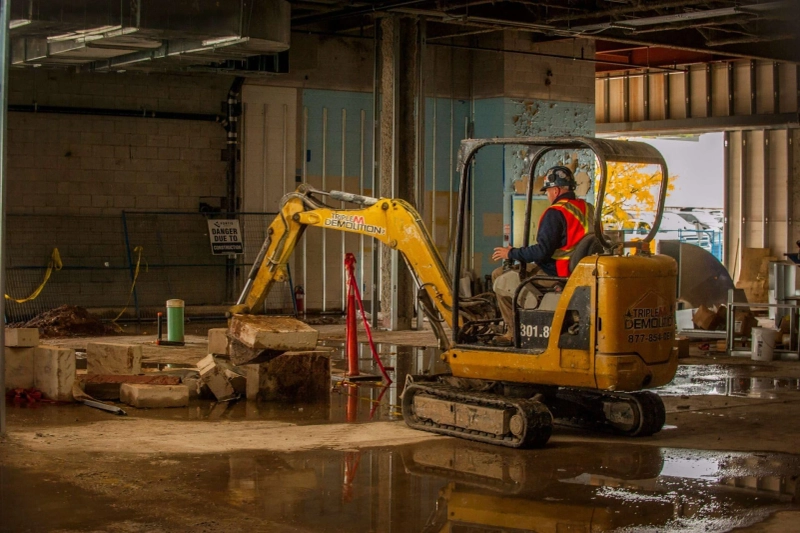Demolition is removing or dismantling an existing structure by a pre-planned and safe method. Every building or construction has an expiration, so after a specific time, it must be demolished. It's challenging to make a demolition decision, but it's necessary to eliminate weak and old buildings before they become a catastrophe.
Tearing down a structure is not always the most ideal or cost-effective solution for partial renovation, and a part of a building needs to be worked on. Selective demolition of existing buildings for renovations can be interior or exterior. Exterior demolition involves partitioning a building in half to make it smaller or to add an extension.
Demolition work may cause accidents and even deaths to workers and the public. Anyone can't do demolition; it must be done under the control of an experienced demolition company.
SELECTIVE DEMOLITION
There are situations where a total demolition of a building is unnecessary and only specific parts need demolition. This type of demolition within an existing building is called selective demolition.
Selective demolition can be applied from small to large-scale, commercial to industrial buildings.
Selective demolition increases efficiency by reducing debris and lessening environmental pollution. It's essential for a sustainable built environment.
BENEFITS OF SELECTIVE DEMOLITION
MAINTAINING THE EXTERIOR OF THE STRUCTUREOne of the leading benefits of selective demolition is that it does not make any changes to the exterior of the building. Here Only selected parts were removed and left the other parts unchanged.
SAVE REUSABLE MATERIALSAnother benefit of selective demolition is its ability to save reusable materials. Some value items can be reused, and others can be recyclable.
REDUCES WASTES AND ENVIRONMENTAL POLLUTION.Selective demolition helps to reduce waste and environmental pollution. The amount of debris generated after selective demolition is lesser than other demolition debris. Because of that, waste removal is an easy task. This method is considered an environment-friendly demolition.
HOW DOES CONTROLLED DEMOLITION WORK
Controlled demolition is the demolition of buildings or structures using explosives, also known as explosive demolition or implosion. Every demolition methods have advantages and disadvantages, and each method follows different strategies. Explosive demolition methods are a viable solution to demolishing extraordinarily tall and strong concrete buildings such as skyscrapers, cool towers, chimney stacks, and bridges. Controlled demolition is considered the safest and quickest way to bring down these types of structures.
It takes more than one month to get a structure ready for controlled demolition. Before demolition, remove materials such as copper wire, glass, insulation, drywall from a building. The demolition crew put high explosives such as nitroglycerin, TNT, RDX on selected floors so that the building structure fell at multiple points.
The main problem in tearing down a building is managing which way it falls. Ideally, a demolition crew will drop the building into an open area or parking lot. The implosion method is the easiest to perform, and it is the safest way.
COMMON DEMOLITION METHODS
1.TOTAL DEMOLITION
Total demolition is the demolition of an entire building, most commonly used to restructure structures.
The different demolition methods are given below.
a) EXPLOSIVE DEMOLITIONIt is the type of demolition where explosives destroy buildings.
This method is commonly used in highly tall and strong concrete buildings such as towers, skyscrapers, chimney stacks. It is the fastest and safest way to bring down a large structure.
b) CHEMICAL DEMOLITIONThis method involves using a concrete cracking chemical that has expansive power that demolishes a massive building with minimum time and effort. This concrete cracking powder is non-explosive and soundless. This method is safer and more cost-effective than explosive demolition.
c) MECHANICAL DEMOLITIONThis method involves using mechanical tools and equipment such as hydraulic excavators, cranes, bulldozers, high-reach arm machines that can break concrete and steel structures apart. Excavators cannot demolish extremely tall buildings; in such a situation, cranes with wrecking balls are used to demolish structures.
SELECTIVE DEMOLITIONThere are instances where new sections are built as a part of an old building; as time goes, old buildings become weak and are not performing well, then they must be demolished and built up from scratch. In this situation, the selective demolition method is used. As the name suggests, this method removes selective parts of a building.
INTERIOR DEMOLITIONThis demolition method removes specific parts inside a building without damaging the exterior structure. For example, walls, beams, ceilings, etc.
STRIP-OUT DEMOLITIONThis method involves carefully dismantling a building to preserve the material and parts for reuse or recycling.
The demolition process depends upon various factors such as the age of the building, location, type, and height of the structure.
Controlled demolition is one of the safest and most efficient methods; it ensures the safety of both workers and the public. It is concluded that demolition is one of the most challenging processes. Demolition must be well planned to prevent accidents and injuries. So before starting any demolition process, one must do a building survey; it helps minimize the risk.
0



